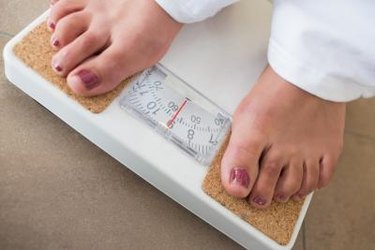
If you're injured, losing weight is not only difficult, but the entire situation can create a downward spiral of increasingly poor health. Because you're hurt, you can't exercise to help yourself lose weight. The extra weight impacts your health, including your ability to heal from the injury. To maintain a healthy weight while injured, all of your progress has to come from close attention to your diet. Your weight loss won't be as fast as if you could support it with exercise, but it will come if you're faithful to your diet plan.
Step 1

Spend one week keeping track of your activity level, using one-hour or half-hour increments. At the end of the week, use a calorie burn estimator to calculate how many calories you burned over the course of the week.
Video of the Day
Step 2

Divide the number of calories burned by seven. This is your average calorie burn per day. It's likely that, since you're recuperating, this will be significantly lower than the average 1,800 to 2,400 calories burned by most adults.
Step 3

Develop a diet plan in which you eat 500 to 600 fewer calories per day than you burn. You can use written or online resources to create this diet. If you're going to physical therapy or the hospital as part of your recuperation, the staff there may be able to help you with this.
Step 4

Base your diet plan on six small meals per day rather than three large meals. This helps regulate your blood sugar and helps you to avoid food cravings between meals.
Step 5

Eliminate low-value, high-calorie foods like sweets and refined carbohydrates from your diet. Lean proteins, fruits and vegetables provide more value and let you eat more while remaining inside your calorie budget.
Step 6

Take a multivitamin to help you get all the nutrition you need despite eating less. Check with your medical team to see if there are also specific supplements you can take to help you heal from your particular injury.
Step 7

Talk with your doctor about what exercise you can do. Very few injuries are actually so severe that you can't exercise at all. Try to develop a simple workout plan -- even if it's only attending your physical therapy -- to increase your daily calorie burn. This means you get to eat more, which makes the weight loss that much easier.
Step 8

Weigh in once each week to check your progress. Under this plan, you'll lose about 1 lb. per week -- the maximum rate of healthy weight loss using only diet, according to Kaiser Permanente's "Healthwise Handbook." If your injury restricts your mobility too much to use a scale at home, keep track of your weight when they check it for your doctor visits.
Warning
You should always check with your doctor before beginning any weight-loss program, but it's even more important when you're recovering from an injury. Make certain that your weight-loss diet won't interfere with your recuperation.
Video of the Day